When searching for cinnamon rolls King Arthur Flour, home bakers seek more than just ingredients—they want the professional techniques that transform ordinary dough into bakery-quality results. King Arthur Flour's recipe stands out for its precise measurements, attention to dough temperature, and specific flour recommendations that address common home baking pitfalls.
Why King Arthur Flour Makes Superior Cinnamon Rolls
King Arthur Flour's approach to cinnamon rolls begins with their signature unbleached all-purpose flour, milled to a precise protein content of 11.7%. This specific formulation creates the ideal gluten structure—enough to provide structure without becoming tough. Unlike many commercial recipes that use bread flour (which can create dense rolls) or cake flour (which lacks sufficient structure), King Arthur's all-purpose flour hits the sweet spot for tender yet cohesive cinnamon rolls.
Their recipe specifically calls for 4 cups (480g) of King Arthur Unbleached All-Purpose Flour, measured properly by spooning and leveling rather than scooping directly from the bag. This attention to precise measurement reflects their commitment to consistent results—a critical factor often overlooked in amateur baking attempts.

Essential Ingredients Breakdown
Understanding each component's role in the King Arthur cinnamon roll recipe helps bakers achieve consistent results:
| Ingredient | King Arthur's Recommendation | Professional Purpose |
|---|---|---|
| Flour | 480g Unbleached All-Purpose | Optimal gluten development for tender yet structured rolls |
| Milk | 1 cup warm (110°F/43°C) | Activates yeast without killing it; adds richness |
| Butter | ½ cup unsalted, softened | Creates flaky layers; enhances flavor development |
| Yeast | 2¼ teaspoons instant | Reliable rise without pre-bloom step |
| Cinnamon | 3 tablespoons Vietnamese | Higher oil content for more intense flavor |
Step-by-Step Process for Perfect Results
The King Arthur Flour cinnamon roll technique differs from standard recipes in several key ways that address common home baking failures:
Dough Preparation Secrets
Unlike many recipes that call for scalding milk then cooling it, King Arthur's method uses milk warmed to precisely 110°F (43°C)—the ideal temperature for instant yeast activation. Their recipe omits the traditional yeast blooming step, which professional bakers recognize as unnecessary with modern instant yeast.
When incorporating flour, King Arthur emphasizes adding it gradually while monitoring dough consistency. The ideal dough should clear the sides of the bowl but remain slightly tacky—not completely smooth like bread dough. This slightly higher hydration (approximately 58%) creates the tender crumb cinnamon roll enthusiasts seek.
Rolling and Cutting Technique
One of King Arthur's most valuable contributions to the cinnamon roll baking process is their rolling method. After spreading the filling, they recommend rolling the dough from the long side with even, gentle pressure—not too tight (which squeezes out filling) nor too loose (which creates gaps). Their professional tip: use a bench scraper to help lift the edge for a clean start.
For clean cuts that don't compress the rolls, King Arthur suggests using unflavored dental floss or a sharp serrated knife dragged gently through the dough—never pressing down. This preserves the delicate layers that create that signature pull-apart texture.

Troubleshooting Common Cinnamon Roll Problems
Even when following the King Arthur cinnamon roll recipe precisely, home bakers encounter issues. Here's how to address them:
Dense or Tough Rolls
This typically results from over-flouring during kneading. King Arthur's solution: resist adding extra flour unless absolutely necessary. The dough should feel slightly sticky but become smooth after proper kneading. Using their recommended weight measurements (480g flour) rather than cup measurements prevents this common error.
Filling Leakage
When the cinnamon sugar filling oozes out during baking, it's usually because the butter wasn't sufficiently cooled before spreading. King Arthur recommends melting the butter, then cooling it to room temperature—warm butter melts the sugar prematurely. Their professional trick: mix the sugar filling with 2 tablespoons of flour to help it adhere better.
Uneven Rising
King Arthur's temperature-controlled proofing advice solves this: maintain a consistent 75-80°F (24-27°C) environment. Place the pan of rolls in the oven with just the light on (not heating), or use a proofing setting if available. Their recipe specifies a 1-1.5 hour rise until doubled—not by time, but by visual cues.
Professional Variations Worth Trying
While the classic King Arthur cinnamon roll recipe is beloved, their test kitchen offers thoughtful variations that maintain structural integrity:
- Cheese addition: 4 ounces of softened cream cheese in the dough creates richer flavor without compromising rise
- Whole wheat adaptation: Substitute 1 cup of all-purpose flour with King Arthur White Whole Wheat Flour
- Overnight method: Refrigerate shaped rolls for 8-12 hours, then bring to room temperature before baking
These modifications follow King Arthur's principle of maintaining the recipe's fundamental chemistry while introducing new flavors—a approach that distinguishes their professional baking recommendations from casual recipe variations.
Frequently Asked Questions
Can I use bread flour instead of King Arthur All-Purpose in their cinnamon roll recipe?
King Arthur specifically recommends against substituting bread flour in their cinnamon roll recipe. Their all-purpose flour's 11.7% protein content creates the ideal tender-yet-structured crumb. Bread flour (typically 12-14% protein) develops too much gluten, resulting in dense, chewy rolls rather than the light, pull-apart texture characteristic of quality cinnamon rolls.
Why does King Arthur Flour's cinnamon roll recipe use instant yeast instead of active dry?
King Arthur uses instant yeast because it doesn't require pre-dissolving in liquid, creating more consistent activation. Modern instant yeast has smaller granules that dissolve directly into dough. Their recipe formulation accounts for instant yeast's slightly faster action, resulting in more predictable rise times—critical for home bakers who often struggle with inconsistent yeast activation in traditional recipes.
How can I prevent my King Arthur cinnamon rolls from becoming dry when reheating?
King Arthur's test kitchen recommends wrapping individual rolls in a damp paper towel before microwaving for 10-15 seconds. For oven reheating, place rolls on a parchment-lined baking sheet, cover loosely with foil, and warm at 325°F (163°C) for 8-10 minutes. Their research shows this preserves moisture better than direct microwave exposure, which evaporates the delicate butter content that gives cinnamon rolls their signature texture.
What's the secret to King Arthur's particularly flavorful cinnamon filling?
King Arthur uses Vietnamese cinnamon, which contains 3-4 times more cinnamaldehyde (the compound responsible for cinnamon flavor) than common cassia cinnamon. Their filling ratio of 3 tablespoons cinnamon to 1 cup sugar creates intense flavor without overwhelming sweetness. Professional bakers note that their method of mixing the cinnamon-sugar with 2 tablespoons of flour prevents settling and ensures even distribution throughout the roll.
Can I freeze King Arthur Flour's cinnamon roll dough successfully?
Yes, King Arthur's recipe adapts well to freezing. Shape the rolls, place them on a parchment-lined baking sheet, and freeze until solid (about 2 hours). Transfer to an airtight container for up to 3 months. To bake, place frozen rolls in a greased pan, cover, and allow 4-5 hours at room temperature to thaw and rise before baking. Their test kitchen confirms this method preserves texture better than freezing fully baked rolls.











 浙公网安备
33010002000092号
浙公网安备
33010002000092号 浙B2-20120091-4
浙B2-20120091-4